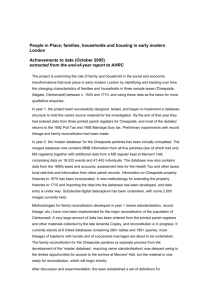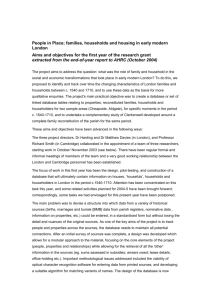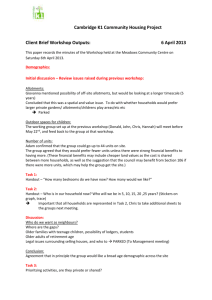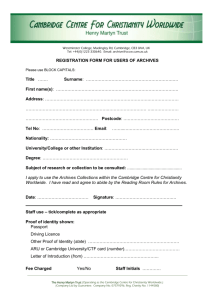People in Place: families, households and housing in - SAS
advertisement
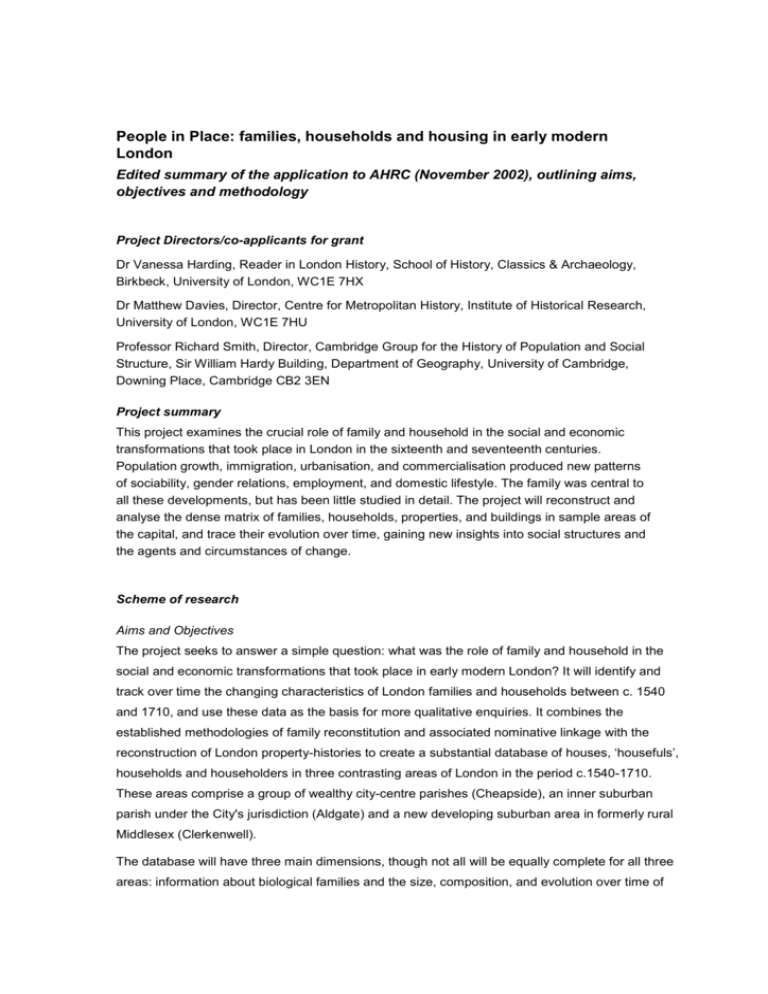
People in Place: families, households and housing in early modern London Edited summary of the application to AHRC (November 2002), outlining aims, objectives and methodology Project Directors/co-applicants for grant Dr Vanessa Harding, Reader in London History, School of History, Classics & Archaeology, Birkbeck, University of London, WC1E 7HX Dr Matthew Davies, Director, Centre for Metropolitan History, Institute of Historical Research, University of London, WC1E 7HU Professor Richard Smith, Director, Cambridge Group for the History of Population and Social Structure, Sir William Hardy Building, Department of Geography, University of Cambridge, Downing Place, Cambridge CB2 3EN Project summary This project examines the crucial role of family and household in the social and economic transformations that took place in London in the sixteenth and seventeenth centuries. Population growth, immigration, urbanisation, and commercialisation produced new patterns of sociability, gender relations, employment, and domestic lifestyle. The family was central to all these developments, but has been little studied in detail. The project will reconstruct and analyse the dense matrix of families, households, properties, and buildings in sample areas of the capital, and trace their evolution over time, gaining new insights into social structures and the agents and circumstances of change. Scheme of research Aims and Objectives The project seeks to answer a simple question: what was the role of family and household in the social and economic transformations that took place in early modern London? It will identify and track over time the changing characteristics of London families and households between c. 1540 and 1710, and use these data as the basis for more qualitative enquiries. It combines the established methodologies of family reconstitution and associated nominative linkage with the reconstruction of London property-histories to create a substantial database of houses, ‘housefuls’, households and householders in three contrasting areas of London in the period c.1540-1710. These areas comprise a group of wealthy city-centre parishes (Cheapside), an inner suburban parish under the City's jurisdiction (Aldgate) and a new developing suburban area in formerly rural Middlesex (Clerkenwell). The database will have three main dimensions, though not all will be equally complete for all three areas: information about biological families and the size, composition, and evolution over time of co-resident domestic groups; information about the spaces and premises occupied by households; and information on the economic status (occupations, wealth, standard of living) of those households. The data can be reviewed cross-sectionally, yielding a picture of the character and distribution of the population of the sample areas at specific moments in time, or diachronically, tracing the changing size, composition and other attributes of co-resident groups and biological families in the sample areas. GIS techniques will map residential locations and relationships (biological, marital, service, business, associational) between households in the sample parishes, and allow us to consider the constitution of 'neighbourhood' and 'community' in both social and spatial terms. By taking three sample areas, the project will highlight variations in the major attributes of the database across space as well as time. The result will be an unprecedentedly rich and detailed understanding of an historical population in its physical environment, through a period of considerable structural and cultural change. In methodological terms, the project's originality lies in integrating two distinct procedures (property history and family reconstitution) for the first time, and creating and analysing census-type, crosssectional data as a means of linking the two. This combined approach multiplies the potential of existing archival, methodological, and technical resources. It will generate a ‘master’ database to which other evidence can be attached by those working on the project, and which will be available for further elaboration by others thereafter. The findings of the project will be disseminated in a multi-authored report and in research papers. Research questions The project will focus on four themes: structure, environment, economy, and relationships. 1. In what structural ways did London families change between c. 1540 and 1710? Did biological families become larger, smaller, more fragmented, longer- or shorter-lasting? Did fertility fall and infant and child mortality worsen over the seventeenth century, as some limited evidence suggests? Did mean household size change, or the distribution of population between units of different sizes or compositions? What was the relative impact of factors such as immigration, population turnover, high infant and recurrent epidemic mortality, and the changing gender balance of the population, on family forms in London? 2. How did families and households interact with the built environment? How was the household unit affected by changes in living conditions (greater density of settlement, higher property values, changing provision for the poor, unregulated building development, worsening environmental quality)? How did understandings of space, privacy, amenity change? How did the social topography of the capital evolve? 3. How was the household-economy affected by the growth of new industries, professions, and domestic service? Did 'family' and 'household' have a different economic significance by the end of the period? 4. What was the significance of family in a broader sense, in the metropolitan context? How important were kinship networks and biological or marital links to the formation of support groups, inheritance strategies, business and credit opportunities? How far can changing affective and power relations within and between households be related to changes in family size and structure? Research context The context of this enquiry is the transformation of England's society and economy in the sixteenth and seventeenth centuries. Explorations of the processes of change at work at the local level underpin large-scale explanations, and the significance of the metropolis must be crucial. An analysis of the London family and how it developed over the period 1500-1700 will give us new insights into the complexities of the capital's social organisation and the dynamics of change. London's population increased tenfold between 1500 and 1700, largely through immigration. Many characteristics of the population, such as their origins, age and sex ratios, skills and employment prospects, altered significantly, as did their economic and social opportunities. Immigration, urbanisation, and commercialisation fostered new patterns of sociability, gender relations, employment, and consumption. These developments undoubtedly affected the size and shape of both family and household. Tracing objective changes to family size and structure over a long period - the first time this task has been attempted - and examining relations within and between households will contribute important new information and understanding. Research in the 1980s and early 1990s made major advances in a range of topics, such as marriage, demography, social and political structures, neighbourhood and community, mostly focusing on sixteenth- and early seventeenth-century London. By taking family and household as an overall theme it should be possible to draw together some of this work and link it with studies of late seventeenth- and early eighteenth-century London society to develop a longer-run argument about the ways in which London society changed. Research methods The project's main practical objective is to create a database or set of linked database tables relating to properties, reconstituted families, households and householders for two sample areas (Cheapside, Aldgate), for specific moments in the period c. 1540-1710, and to undertake a complementary study of Clerkenwell developed around a complete family reconstitution of the parish for the same period. The starting-point is the archive of property histories held at the Centre for Metropolitan History (CMH) in London, covering five city-centre parishes in Cheapside and, less comprehensively, the extramural parish of St Botolph without Aldgate, from the twelfth century to c. 1670. (1) This project will extend the property-histories for these areas to c. 1710, exploiting a number of rich new sources (particularly tax data and inventories) available after c. 1660. These extended and completed histories will yield a large directory of householders from c. 1540 to 1710, which will form the primary structure of the database, and contribute other information for the subsidiary fields. They will also provide the basis for spatial analysis and distribution mapping. (cf. 2) The Cambridge Group for the History of Population and Social Structure (CPG) will provide the expertise for the reconstitution of the resident population of the Cheapside parishes, using parish register data from c. 1540-1740 (some 18-20,000 events). CPG has established principles and protocols for family reconstitution over many years, and is the ideal environment in which to solve methodological obstacles to this research. There is an experimental aspect to this part of the project, since mobile urban populations are notoriously difficult to reconstitute, but the use of a group of contiguous parishes within intra-mural London should significantly reduce the severest aspects of this obstacle. Pilot studies are currently being undertaken with some of this material to identify problems and best procedures. CPG has also addressed many of the conceptual and methodological problems involved in linking family reconstitutions with the synchronic information about householders and household structure derived from listings of inhabitants, tax and rate assessments. The extensive tax records of the 1690s include a virtual census of the population of four of the Cheapside parishes (about 1,500 individuals) and of St Botolph Aldgate (about 8,000 individuals), which establishes a crucial link between property histories and demographic reconstructions, helping to place families in properties. The reconstituted Cheapside families will be selectively linked to other evidence, focusing on three distinct periods, working backwards from the best-documented to the most problematic: 1675-1700; 1625-50; and 1550-75. The absence of a major cross-sectional source for 1550-75 restricts linkage possibilities but this period will provide an essential point of reference for the later studies. A comparable analysis of Aldgate families and properties for 1675-1700 will be complemented by a separate analysis of the rich demographic and biographical data in the Aldgate parish clerks' memoranda books for c. 1580-1600. An important comparative dimension to the city-based part of the project will be provided by exploring CPG's archive of material on the suburban parish of Clerkenwell, collected by the late Amanda Copley. Nominative evidence from tax returns, rate assessments, poor law payments and censuses, churchwardens' accounts and vestry minutes will be linked to the family reconstitution which will be generated out of data sets of demographic events (59,000 burials, 41,000 baptisms and 15,000 marriages, scanned from printed parish registers). Research team. The research team will comprise the 3 co-applicants as project directors, each contributing a fraction of their time in research and supervision. a technical consultant (Ms Ros Davies), in Cambridge one full-time research officer, supervised by Dr Harding and Dr Davies, in London one half-time clerical assistant, supervised by Dr Harding and Dr Davies, in London one full-time data editor, supervised by Dr Smith and Ms Davies, in Cambridge Work will take place in both London and Cambridge. There will be frequent contact, including regular meetings of the whole team, and continual collaboration, sharing data and developing joint conclusions. Both teams will collaborate in the process of data integration and analysis, and in writing the final report. The London team's objective will be the continuation of the property histories for Cheapside and Aldgate; the development and enhancement of the database of householders; and exploration of mapping techniques. The research officer, who will have post-doctoral status and appropriate palaeographical and research skills, will be responsible for primary research in archives and record offices (mostly in London), using a laptop computer, and for writing it up. The clerical assistant will transcribe and input data, inventory sources, and manage the database. Both individuals will be accommodated in CMH's premises and in regular contact with Dr Harding and Dr Davies. Dr Harding will be on research leave, and contributing more to the project, in 2004-5. The Cambridge team will undertake the family reconstitution work for Cheapside and the various nominative links for Aldgate, transcribing, inputting and processing the demographic data, using filmed or copied material; the completion of the family reconstitution for Clerkenwell and the subsequent linkage of the individual records created in that exercise to other sources; and consideration of the 'macrogeographical' potential of the cross-sectional sources for London in the 1690s. Dr Smith will be on leave for two academic terms in 2004-5. The project will receive intellectual and methodological support from the appointment of a small panel of expert advisers, meeting regularly in London and Cambridge as an informal seminar and receiving progress reports. In addition to the database and the final report, the team will produce a series of reports or working papers on procedures, methodologies, and findings for consideration at workshops involving the advisory committee and invited experts held at intervals over the course of the project. We also aim to present papers on the project at appropriate conferences in Britain and abroad, such as the annual Pre-Modern Towns Group meeting, the Economic History Society Conference, and the biennial conference of the European Association of Urban Historians (meeting in Athens in 2004 and Stockholm in 2006). References: (1) Keene, D.J., and Harding, V.A., Historical Gazetteer of London before the Great Fire, i, Cheapside (microfiche, Chadwyck-Healey 1987); Carlin, M., 'Historical Gazetteer of London before the Great Fire. St Botolph Aldgate' (Typescript, CMH/ IHR, 1987) (2) Spence, C. A social atlas of London in the 1690s (CMH, 2000) Research outputs envisaged 1. A multi-authored report on the procedures and findings of the project, centring on an analysis of families and households in the sample areas at three periods (c. 1550-75; c. 1625-50; c. 16751700). Its primary audience will be economic and social historians and historical geographers, but it will also explain how the database can be further explored and utilised by a wider constituency. To be published in the Centre for Metropolitan History (CMH) Working Papers series. 2. An electronic database of households/householders in the sample areas, as described in the project outline/technical appendix. To be deposited in AHDS, accessible via CMH and Cambridge Population Group, and possibly in time available freely online via CMH's website 3. Reports on progress and the proceedings of seminars/symposia will be published in CMH's annual report. 4. Papers on methodologies and interim results will be presented at research seminars and conferences, national and international, and submitted for publication in appropriate journals. 5. In parallel with the research project, Dr Harding will be working on a monograph on The metropolitan family, 1500-1700, drawing on the projects's findings for family structure and change over time, but also considering other themes (e.g. marriage patterns, relationships, kinship, family health).
